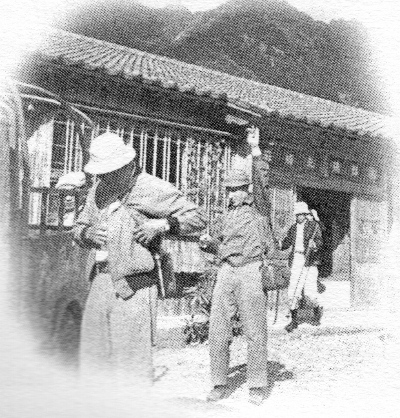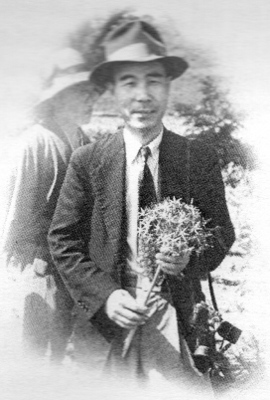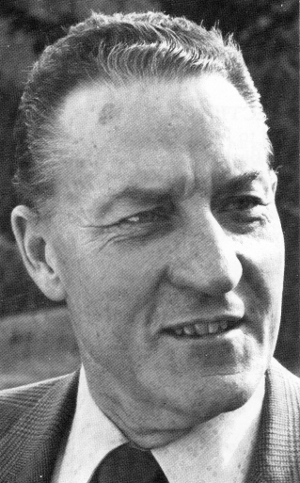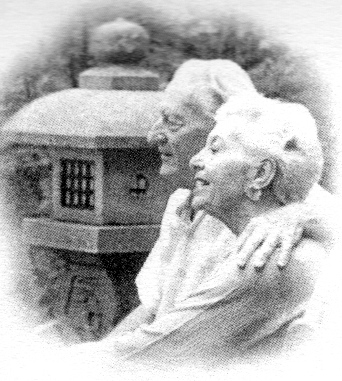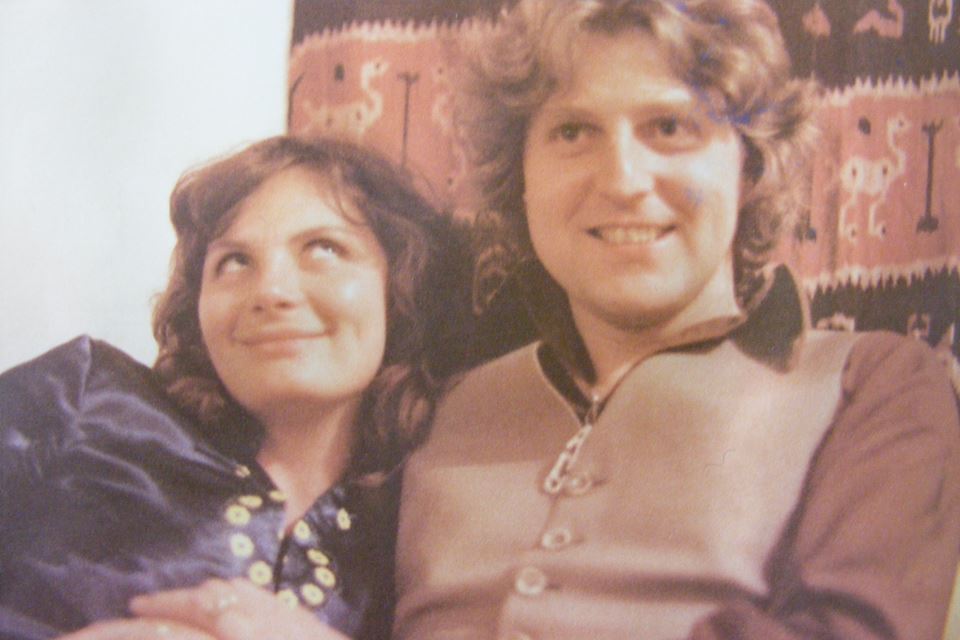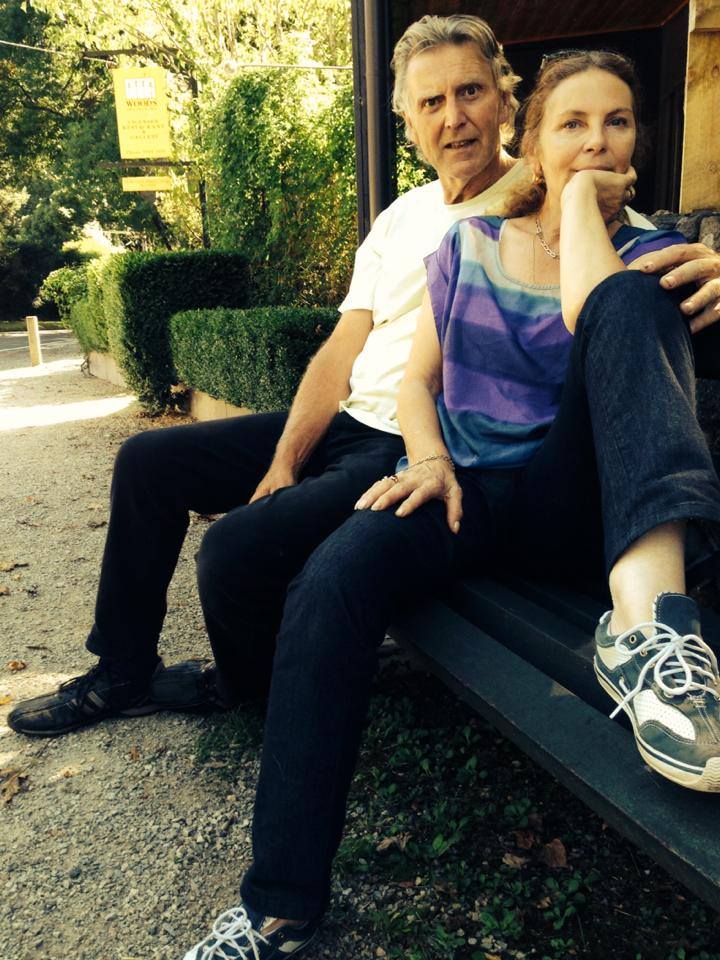| 1 |
1915 -- Peter Mutsumi Sugawara was born in Salinas, CA. [He would serve as a
sergeant in the
442nd Regimental Combat Team,
the all Japanese-American unit of the US Army, during World War II, and would be honorably discharged in
November, 1945. He would then settle in Los Altos, CA in 1954 with his first wife, Kiyo (d. 1968), and
four children. Pete would be the sole proprietor of the Monte Bello Nursery until his retirement in
1980. In addition to the usual fare, the nursery would carry rare and unusual, plants, many of which
Pete propagated himself. Monte Bello would often be mentioned as a prime source in Sunset
Magazine. The nursery would be among the first to carry fine Japanese bonsai pots. These
would be sold in the Monte Bello gift shop presided over by his second wife, Amy (d. 2000). A
well-respected nurseryman and bonsai enthusiast, Pete would be active in the California Nurserymen'
Association, the Kusamura Bonsai Club
(he'd be elected in 1961 as the group's first president), the Golden State Bonsai
Federation (Pete and Amy were at the founding meeting), and the San Francisco chapter of Ikebana
International. A 48"H formal upright Coast redwood (Sequoia sempervirens) was created about 1954
by Pete. Purchased in 1972, it was trained with the advice of Sugawara and donated by June M. Chambers
of Woodside, CA to the North American Collection of the
National Bonsai and Penjing
Museum. It resides in a Japanese container of Tokoname ware. Pete would pass away in
2003. He would have bequeathed his entire collection of bonsai, pots, and tools to the GSBF and several
of his bonsai would be on display at the GSBF Collection North. [As Randy Davis would comment in 2020 seeing the below ad, "Very cool to see Peter's Ad - 'Hello, Monte Bello Nursery, how can I help you?' So many fond memories of that 5 acres of rare and hard to find trees. Thanks for the view down memory lane, Robert Baran. It's all a memory now, the nursery and the Original Crew (Peter Sugawara, Kay Sanfilllipo [sic], Spencer Sato, Mike Heraria) are no longer here and I miss them all. There were so many significant luminaries of California Horticulture and American Bonsai that both walked and worked on that piece of ground."] 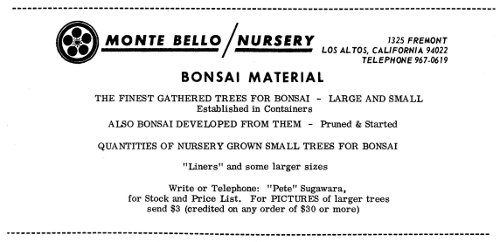
(Bonsai, BCI, October 1969, pg. 11)
(Obituaries, Los Altos Town Crier,
http://latc.com/2003/03/19/people/obituaries.news01.print.html
; "In Memoriam," Kusamura Bonsai Club,
http://www.gsbf-bonsai.org/kusamura/april2003/memoriam.html
; "The National Collection of North American Bonsai,"
http://www.gwu.edu/~jeffstep/bonsai/nbf/bwc/bwc_no_am.html
; Randy Clark comment on FB Oct. 20, 2020) SEE ALSO: Feb 25, Mar 10, Nov 6
2011 -- Alice Toshiko Mizunaga Naka died. (Long-time wife and companion of Grandmaster John Naka, Alice edited his books Bonsai Techniques I and II, and distributed tens of thousands of copies of these important and influential works. Additionally, she cared for the priceless bonsai collection in their backyard when John was on the road worldwide teaching the art of bonsai. And lovingly raised sons Gene, Bob, and Dick, eleven grandchildren, and twelve great-grandchildren.) (Manning, Cheryl "Alice Naka, September 19, 1917-August 1, 2011," National Bonsai Foundation, Fall/Winter 2011 newsletter, pg. 1.) |
||||||||
| 2 |
|
||||||||
| 3 |
1903 -- George Sherman Avery, Jr. was born. [He would go on to
become a botanical researcher with a Ph.D. in plant physiology from the
University of Wisconsin, director of the Connecticut Arboretum in New London,
and professor of botany at Connecticut College. In 1944 he would
be named director of the
Brooklyn Botanic Garden, and the
following year establish the quarterly
Plants & Gardens
journal. Special editions of these would be reprinted as a handbook series for
which the Garden would be recognized and acclaimed. In the first handbook he
would identifiy his intent "to make available to people everywhere the
horticultural experience gained in this institution." By 1948 Dr.
Avery would have hired Japanese gardener Frank Okamura to begin work on
the surviving trees from Ernest F. Coe's 1925 gift of bonsai to the BBG.
(Okamura would also have rejuvenated the BBG's Japanese Garden, which would
be cautiously called the "Oriental Garden" during the second world war.)
[After WWII and during the Occupation Period through the Korean Conflict, there would be increasing numbers of letters to the Brooklyn Botanic Garden from U.S. Army personnel in Japan inquiring how they could arrange to bring bonsai back into the States. Plant quarantine rules would make it practically impossible, though a few servicemen would manage to smuggle small bonsai in their rucksacks. Once back, there would be many inquiries on how to take care of these. (By the way, some of these "rucksack bonsai," including a Chinese juniper, would end up on display at the BBG.) [When these letters grew to several a week, the director of the Garden, Dr. Avery, would realize there was a need for a handbook on the subject. He would send a circumspect letter out to six well-known and highly respected horticulturists at different public gardens around the country, mentioning the growing interest as measured by BBG plant information correspondence. Did they think such a handbook was warranted or that there might be a demand for it? All of them would advise against the idea. [Avery would ignore them, and invite Japanese horticulturist Kanichiro Yashiroda to be the guest editor. A one-time student gardener at the Royal Botanic garden at Kew in London, Yashiroda would invite amateur and professional Japanese bonsaimen to write for the handbook-to-be and laboriously translate their articles into English. (Although he would have spent a year at Kew, during the war years his English would go unused.) The typed manuscript and photographs would arrive at the BBG late in 1952, and after a bit of editorial work by Frances Miner and Dr. Avery, Bonsai -- Dwarf Potted Trees was published as the Autumn 1953 issue of Plants & Gardens. It would be practically an overnight success and for a few years the only English-language guide to the subject readily available in this country. [The BBG Instruction Department then would set up a learn-by-doing bonsai class in 1954 with Dr. Avery and Frank Okamura presenting the 3-session beginners' course. Nearly a hundred people from all walks of life would initially attend. [In 1958 Dr. Avery would invite Japanese teacher Yuji Yoshimura to come to the BBG. Two years later Dr. and Mrs. Avery would go to Japan with instructions and gift funds (from 1958) in hand to purchase "distinguished" older bonsai for the BBG's expanding collection. He would head the BBG until 1969. And by the following year, some five thousand students would have graduated from the Garden's series of bonsai classes. Additionally, Dr. Avery would serve as secretary of the Botanical Society of America 1937-39, vice-president in 1943, and president in 1957. He would be recipient of the American Horticultural Society Professional Award in 1970, and receive the Scott Arboretum's Arthur Hoyt Scott Medal and Award in 1974. (Bonsai -- Dwarf Potted Trees would see thirty-eight printings through Nov. 1988 alone. Handbook on Bonsai: Special Techniques, a companion volume released in 1956 and also edited by Yashiroda, would see its twentieth printing by that date as well.)] (Mae Pan, BBG Archivist, in correspondence to RJB Feb. 20, 2002, including Dr. Avery's obituary in Plants & Gardens, Vol. 50, No. 3, 1994; Scholtz, Elizabeth "Japanese Beginnings at Brooklyn Botanic Garden," Journal, ABS, Vol. 13, No. 1, Spring 1979, pp. 4, 6, 7; Hobbs, Mary M. "Wind Governs Gardening," Bonsai Magazine, BCI, Vol. XII, No. 1, January/February 1973, pg. 17; O'Connell, Jean "The Art of Bonsai," Science Digest, March 1970, pg. 38; "Bonsai in Brooklyn," Life, May 23, 1955, pp. 84, 87-88; Elvin McDonald's Foreword in Tomlinson, Harry The Complete Book of Bonsai (New York: Abbeville Press, Inc.; 1990), pg. 6; "Past and Present Officers of the Botanical Society of America," http://www.botany.org/bsa/membership/past-off.html ; "Scott Arboretum: A. Hoyt Scott Award Recipients," http://www.scottarboretum.org/pages/medalpast.html ; "Past American Horticultural Society National Award Winners," http://www.ahs.org/about/abpastwin.htm.) SEE ALSO: Jan 1, Jan 12, Jul 13, Aug 6. 1992 -- The alt.bonsai newsgroup began today as the Bonsai Discussion List (BONSAI@WAYNEST1.BITNET). [During its first calendar month it would see 100 postings by 15 persons from the U.S. and Canada on such topics as art vs. nature, Azalea forest, Japanese Black Pines, collecting trees, suggestions for indoor bonsai specimens, mugo pines, suggested soil mixes, cold frames, moss, aerial roots, rock plantings, penjing plantings, and watering. Keith Sedgwick would post 37 times and serve as a moderator of sorts.] 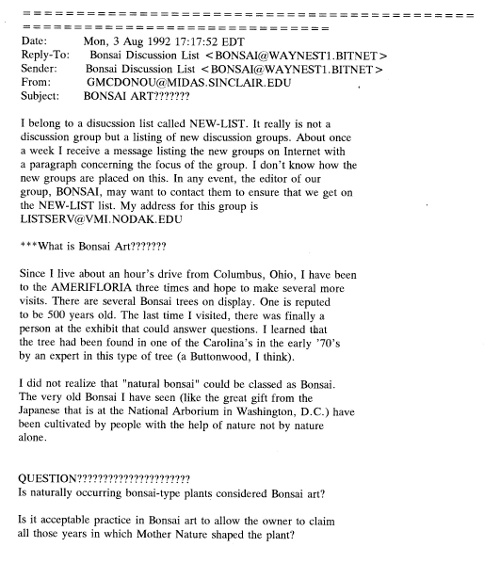
("IBC Bonsai on the Internet history," e-mail from Chris Cochrane to the IBC, BONSAI@HOME.EASE.LSOFT.COM on 3 Feb 2006; scan from printout which RJB made on 21 Apr 1995 of just over a hundred pages for the postings for the month of Aug 92, which can now be seen in four parts here, here, here, and here.) SEE ALSO: Apr 9, Jan 26 |
||||||||
| 4 |
2014 - Shohin bonsai expert Doris W. Froning died in New Wilmington, PA at age 93.
(She was preceded in death by her husband of 61 years in 2001; and by her two sons, Peter (2002) and Michael (2013).
Dorie is survived by her daughters, Anne (Mark) Laboe of Monroe, MI and Mary (Ron Ballard) Froning of Washington, D.C.;
her son, Andrew (Susan) Froning of Kennett Square, PA; her daughter-in-law, Lyn of Birmingham, AL; 11 grandchildren; 16
great grandchildren; and her beloved caretakers for the last years of her life, Thomas and Victoria Jeker.)
("Doris W. Froning (1921 - 2014)" obituary, published in The News Journal on Aug. 7, 2014, http://www.legacy.com/obituaries/delawareonline/obituary.aspx?pid=171999308.) SEE ALSO: Mar 26 |
||||||||
| 5 |
|
||||||||
| 6 |
1945 -- At 8:15 a.m., an American B-29 bomber dropped a 12 to 15 mega-ton-yield
atomic bomb on the Japanese city of Hiroshima,
a designated miltary target. The bomb exploded 1900 feet above
the city, flattened
all buildings within a 3 to 4 square mile area, and initiated a firestorm which burned
nearly everything that had not already been destroyed by the blast in a roughly circular
area of 4.4 square miles around the point directly under the explosion. A hundred thousand Japanese died outright.
[Close to that number again would die from burns and radiation sickness. Hundreds would be disfigured.] (The 16-day
Potsdam Conference involving U.S. Pres.
Harry S Truman, Soviet Gen. Josef Stalin, and British Prime Minister Winston
Churchill had ended Aug. 2 with Tokyo rejecting a call upon Japan to surrender.
Two days later U.S. planes dropped leaflets over Hiroshima warning "Your
city will be obliterated unless your Government surrenders.") [On
Aug. 9 a 20 to 25 mega-ton-yield plutonium-core bomb would be dropped on Nagasaki,
killing 75,000 outright and close to that number again from lingering effects.
Imperial Japan would sue for peace the next day, and accept the Allied surrender
terms on Aug. 14. Signing those terms on Sept. 2, Japan would end
its eight year long war and prevent what potentially could have been a
drawn-out invasion by Allied troops of the Japanese islands.]
One reason why this is important to us: Three kilometers [sic] from ground zero was the Yamaki family compound. All the members were inside at the time and each was cut by flying glass fragments. Miraculously, however, none of them suffered any permanent injury. An old Japanese white pine ( Pinus parviflora 'Miyajima') and a large number of other bonsai were sitting on benches in the garden behind the house, which was also a commercial nursery. Amazingly, none of these bonsai were harmed by the blast either, because the nursery was protected by a tall wall. [The Japanese Broadcasting Cooperation would later film the bonsai garden and report on how the wall had saved the bonsai. That old bonsai, approximately 375 years old entering the 21st century, would be the largest specimen (41-1/4" or 105 cm tall) in the Japanese gift to the United States for the latter's Bicentennial some thirty-one years later. It would be donated by bonsai master Masaru Yamaki, who had been a very influential member of the Japanese bonsai community and who would live to the age of 89 years. Yamaki-san had learned the art and science of bonsai from his father and, following the close of WWII, would be one of the leaders of the effort to revive bonsai as a commercial enterprise in Japan. He would be well-known for both his masterpiece Japanese black as well as Japanese white pines, including some of the very unusual Nishiki (corky bark) Japanese white pines. The aforementioned large old tree originally came from Miyajima (literally "Shrine Island"), a 19 mile-in-circumference body south of the city a short distance across Hiroshima Bay, whose white pines are rare and therefore considered very valuable.] [P.S. The close call of this particular bonsai would not become known to the U.S. until the year 2001 when two young men came to the National Arboretum to see their grandfather 's gift, which had been given before they were born. On a return trip to Washington, Shigeru Yamaki brought documentation with him of his grandfather's illustrious career.] To recap: a rare Japanese white pine was born in the south of an Asian island-nation approximately a decade after the Pilgrims' ship Mayflower landed off of Cape Cod on the northeast shores of North America. In a few years the tree would be grafted and made into a hachi-no-ki, the deep-bowl predecessor to bonsai. The containerized tree would be aged about a century and a half and the leaders of its homeland would continue to be isolated from most of the rest of the world when a people, many traceable back to those Pilgrims, declared and fought for their independence as a new country. Their descendents, almost a hundred and seventy years later, would use a new weapon to stop the imperialistic expansion of the descendents of the group to which the tree's original caretakers belonged. The white pine was fortuitously protected by a wall although it was near the center of the weapon's blast. The devastated latter people initially feared the victorious former would behave in a traditional post-war manner with rape and pillage, but the vanquishers instead helped rebuild the ruin and raise the nation to a higher standard of living than it had ever known. The assistance included having some of the briefly occupying troops and/or their families learn some of the native arts, including bonsai. When the younger nation celebrated its two hundredth birthday, a number of trees and stones were gifted by the older country as a living green sign of continuing peace, acknowledging that at least a few in the younger nation could truly appreciate and care for the islands' representatives. The largest and oldest member of the gifts was, of course, that special Japanese white pine, a truly unique specimen in the National Bonsai and Penjing Museum. ("Hiroshima Survivor" by Felix B. Laughlin, NBF Bulletin, Vol. XII, Number 2, Winter 2001, pp. 1, 5, 6 (the web site link to this article has additional wonderful pictures, some in color); The People's Chronology by James Trager, New York: Henry Holt and Company, revised 1994 edition, pp.225, 893; International Bonsai Digest Bicentennial Edition, ed. by Juyne M. Tayson, M.D., Los Angeles: IBD, 1976, pg. 27; The National Bonsai Collection Guidebook, ed. by John Naka and Yuji Yoshimura, Atlanta, GA: Symmes Systems, 1977, pp. 4, 13; Kucan, JO Hiroshima and Nagasaki: Review of the Consequences, Implications in the Post 9/11 World. J Burns & Surg Wound Care [serial online] 2004;3(1):8, which includes the paragraph "In both cities the blast completely destroyed everything within a radius of 1 mile from the center of explosion [emphasis added] . Hiroshima lost its identity as a city. Over one quarter of the population was killed almost instantly and an equal number was seriously injured, so that even if there had been no damage to structures and installations the normal city life would still have been completely shattered. Nearly everything was heavily damaged up to a radius of 3 miles from the blast, and beyond this distance damage, although comparatively light, extended for several more miles. Glass was broken up to 12 miles away." The statement that the family compound was 3 kilometers away from ground zero means that it was thus less than two miles from the center of explosion. The various articles seen -- including some not cited here -- give a range of bomb yields, casualties, areas of destruction, etc., so that true discrepencies between the tale of the survival of the family and trees and the "official" blast summaries are difficult to easily discern.) SEE ALSO: Mar 20, Jul 9 -- and this. 1994 -- Dr. George Sherman Avery, Jr., who headed the Brooklyn Botanic Garden from 1944 to 1969 and built up its bonsai collection while popularizing the hobby, died a few days after his 91st birthday at his home in Connecticut. ("In Memorium," Plants & Gardens, Vol. 50, No. 3, 1994; The New York Times obituary contained a few errors which were then corrected.) SEE ALSO: Aug 3. 2015 -- Thorhammer Nicholas Beowulf died -- and struck out on his next great adventure. (Though hopeful of finalising his doctorate thesis on bonsai in the months remaining to him, the effects of the chemotherapy and the advance of the Stage 4 liver and pancreatic cancer forced him to accept this would not be possible. After chemotherapy was finished in May, the young bonsai artist was moved into hospice during the second half of July in Canberra, Australian Capital Territory where Thor spent his final days.) [His widow, Melissa, and sons hope to publish his work eventually, and have plans for a memorial research library.) (Facebook postings by his wife Melissa on Aug. 4 and Aug. 7; Thorhammer Nicholas Beowulf Memorial Research Library", © 2016 The Beauseant Project.) SEE ALSO: Oct 26. |
||||||||
| 7 |
1996 -- California teacher Sam Shigeo Nakano, age 80, passed away in Los Angeles.
("Sam Shigo Nakano,"
Find-A-Grave) SEE ALSO: Jan 20.
2009 -- Dr. John L. Creech died at age 89 in Columbus, NC. (Born in Woonsocket, RI, he was a graduate of the University of Rhode Island with a BS in Horticulture in 1941. He served in the U.S. Army during WWII, where as a first lieutenant in the "Big Red One," the 1st Infantry Division, he was captured by Erwin Rommel's Africa Corps. He and other POWs were flown to Germany where they were sent to camp OFLAG 64 (Offizier Lager = Officers' Camp) in Schubin, Poland from 1943 until 1945. While there, he was one of the men who raised plants in the 60-foot greenhouse to supplement the food for over 1,500 prisoners. The following March "we spaded that 2-1/2 acres. I started 6,000 tomato plants and talked the Germans into giving us three cold frames, which I filled with beet and lettuce seeds. Since we needed the food desperately, I tried to remember the schemes my brother used back in Rhode Island, in the tiny greenhouse that produced so much each year." Creech received both the Silver Star, for gallantry in battle for his efforts during the mission in Africa, and the Bronze Star, for his efforts in charge of gardening activities in the camp. Creech's military career ended in 1946, though he remained a reservist until 1953. He would become a member of OFLAG 64 Prisoner of War Association. He received his MS Degree from the University of Massachusetts in 1947 and then his PhD from the University of Maryland in 1953 for "Compatability and embryological studies among azaleas." From 30 Sept to 20 Dec, 1956, Dr. Creech, as horticulturist with the USDA Agricultural Research Service, led an exploration organized under the collaborative agreement between Longwood Gardens and the USDA to southern Japan. (Creech had collected ornamental plants in Japan a year earlier. Kaname Kato, "a quiet Japanese gentleman, a scholar, and horticulturist," was the one who introduced Dr. Creech to bonsai that year.) Dr. Hideo Takeda, botanist with the Military Geology Section of the U.S. Army, acted as an outstanding interpreter, guide, and photographer during the entire 1956 period. From this exploration, 668 plants were introduced, half being from the wild. Among them were 219 cultivars of chrysanthemums. An exhibit of these chrysanthemums was shown for the first time at Longwood Gardens during the fall of 1957. Soon Dr. Creech's chrysanthemums were distributed to major growers in the United States. He led a second expedition to Japan for Longwood from 22 April to 23 July 1961. A total of 347 collections of plants, cuttings, and seeds were shipped during the course of that trip. In addition, arrangements were made for the collection of seed from important localities when the seed matured. "I believe that I have brought to America the greatest collection of breeding stocks of important Japanese plants than any-one previous," wrote Creech to Dr. Walter H. Hodge, Longwood's head of education and research. "This is with all due respect to my own earlier trips and other collectors. We now have all the wild camellia, holly, azalea, and similar materials to do some really fine breeding and developmental work with these plants."
A Brocade Pillow: Azaleas of Old Japan was a 1984 English translation by Dr. Creech and Kaname Kato of a 1976 reprint supervised by Yotaro Tsukamoto and sponsored by the Satsuki Society of Japan. The original classic 1692 work by nurseryman Ibei Itō was the first monograph on azaleas either in Japan or elsewhere. Dr. Creech then served in 1986 as interim director of the North Carolina Arboretum and remained active as a member of their Board of Directors until his death. He had been the 1972 recipient of the American Horticultural Society Professional Award and 1989 recipient of the AHS Liberty Hyde Bailey Award. His memoir, The Bonsai Saga: How the Bicentennial Collection Came to America, was published by the U.S. National Arboretum in April 2001. He was a member of several international scientific organizations and he authored or co-authored numerous papers on crop husbandry and forestry production, plant taxonomy, and plant genetics. He was first married to Amy Wentzel Creech who died in 1984 and was the widower of Elaine Innis Creech who died in 2003. He is survived by his fiancée, two daughters, one son, three grandchildren, and two great grandsons.)
|
||||||||
| 8 |
|
||||||||
| 9 |
1947 -- Lindsay Farr was born in Melbourne,
Australia. (His parents met in London in 1945, when his dad had
been in the 2nd AIF and was recently
released from a German POW camp and his mother had been a
WAAAF. Jack wouldn't
talk much about the war after that time. The following year a nursery was opened and Jack would continue
to sell plants, seedlings, flowers, fungicides, and pesticides until he became a restauranteur in the mid-1960s.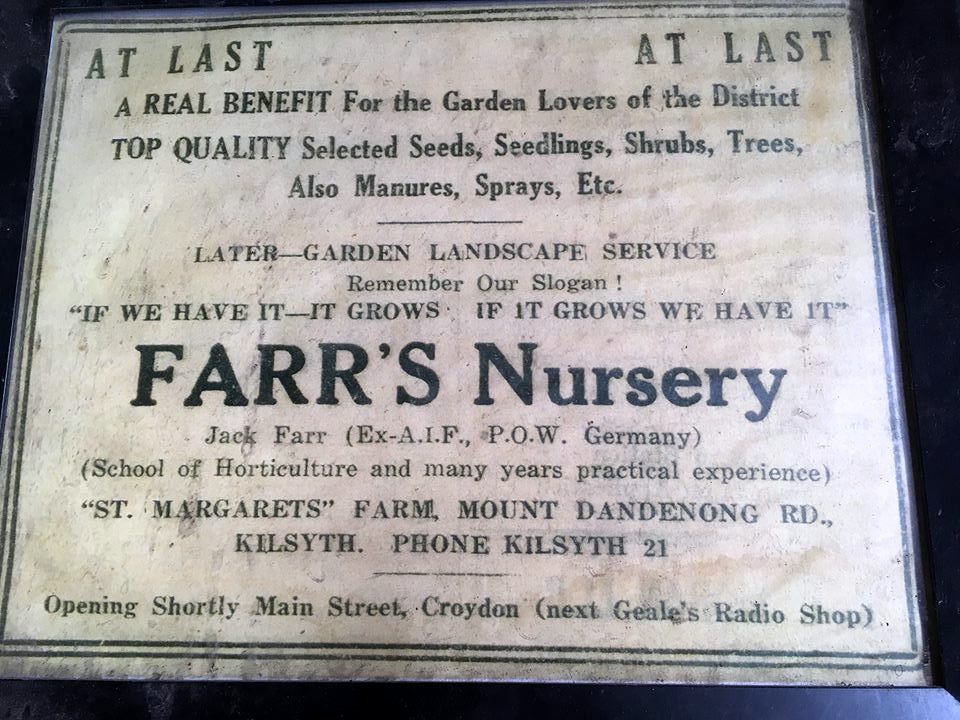
(Lindsay had one sister two years older and then one ten years younger than him. As a five-year-old Lindsay would be introduced to bonsai by a group of ladies looking for bonsai material at the back of his dad's nursery in Croydon, 27 km east of Melbourne's Central Business District. Those particular customers would show him a book with pictures of bonsai and Lindsay would be hooked. In those postwar years bonsai would be a real mystery. One of the ladies would tell him that it was like Chinese foot-binding and if he would plant a maple seed in a table tennis ball this would restrict the root growth and hence the maple would be dwarfed. These same ladies would found the local bonsai club scene and be regular visitors later to Lindsay's Mt. Dandenong bonsai nursery. The most terrifying memory of his early childhood would be when he saw the film The Wizard of Oz and a large apple tree reached out and grabbed someone. Lindsay would run from the picture hall in horror and would long consider that bonsai was a way of overcoming that fear of trees. Maybe he could say "the tree wired me." (Lindsay would dabble in bonsai in early childhood. His first real collection would be realized as a 13-year-old when he mixed bonsai with Rhododendron collecting. He would go on to amass quite a collection of artfully stunted plants. But then his interest in bonsai would diminish briefly when at age 15 he would become the voluntary Aussie Motown rep with the duty of persuading Australian Radio to play the Motown hits. In 1966 he would become a saxophone player and a year later (the same year he then added flute) would be doing gigs with numerous outfits. He would play saxophone with We free Kings at the Geelong Jazz Festival, 1967. He would tour with the Sydney jazz-fusion group Heart'n'Soul in 1969 and be credited for baritone and tenor sax and flute on the group's Hot Boogie Band LP in 1971. Lindsay would also play with the iconic Australian Rock band Daddy Cool. (About this time he would be sharing a house with Chris Löfvén, who'd be an assistant to emerging Hollywood director Fred Schepsi. Chris would be an avid experimental film maker, and be credited with most of the Aussie music videos of the era. As a friend, Lindsay would appear in a number of Chris' films. They would live at 806 Glenferrie Rd., just opposite Barry Iles' office. (Iles would go on to be an influential patron of the emerging Melbourne bonsai scene in the 1960s through the 1980s.) Chris would show Lindsay a guerilla film-making sensibility and create the possibility that anyone could be a film-maker. Lindsay would say he owed much credit to Chris for showing the way. (Lindsay would then go to Southern California with his long-time friend actor Graham Matters. Lindsay would play flute in 5-time USA surfing champ Corkey Carrol's band in San Clemente in 1972 and '73. He would then took a Greyhound bus through the South up to Boston to complete the Jazz Arranging and Composition program at Berklee College of Music. He would do a few tours to North Carolina and Georgia with Boston bands "Black Ice" with Mike Cogswell, and the "Dellistics." (During this time he would maintain a rooftop garden at his Beacon street apartment with several small collected pines, which he would grow in pots made by his future wife Marietta. Now, in 1961, he would have met Marietta Kertesz on a bench outside the Sherbrooke Post Office. Then shortly after Lindsay did graduate from Berklee in Boston in 1977, she would be graduating ceramics at the Art Institute of Boston. They would have been engaged that previous January and then, after returning to Melbourne, they would be married on April 2, 1978. That year he would have a brief but memorable meeting with Japanese teacher Yuji Yoshimura at a Melbourne bonsai convention which was also headlined by Dot and Deb Koreshoff. Lindsay would then work a few years in several radio, television and recording studios whilst planting trees in the field to prepare for his childhood dream of a Bonsai Farm. The Bonsai Farm would begin in Lindsay and Marietta's small suburban backyard but soon would be moved to a larger Nursery at Mt. Dandenong around 50 km east from Melbourne. (He would begin teaching bonsai in the early eighties. For a decade, he would teach at numerous campuses including TAFE the Chinese Museum and The Council of Adult Education. He would later form his own school, The Bonsai Academy of Australia. During the early years of Bonsai Farm, they would pioneer new bonsai markets including major retailers, supermarkets and hardware giants. They would soon become disillusioned by this mass marketing and restructure to a retail garden by the late eighties. During this period Lindsay would publish his free tabloid newspaper Bonsai/Penjing News. Hundreds of thousands of copies would be distributed with requests received from many foreign countries. Sons Dorian and Sam would have come into the world by this time. When the kids were young the family would do an around-the-world-trip. Paul Lesniewicz from the Bonsai Centrum in Heidelberg, Germany would ask Lindsay to call John Naka when the Farrs reached Los Angeles. Lindsay would be instructed to tell John to refrain from sending any more collected California junipers to Germany, because the trees in an earlier shipment had all died. Lindsay and John would speak for no more than 15 minutes on the telephone, but Lindsay would later say that in that 15 minutes he learned a lot about living, a valuable conversation. (Lindsay's first TV bonsai segment would be with Aussie television producer Craig Campbell (Rove) for a Karate Kid cross-promotion on the Saturday morning Cartoon Company program on the Nine Network. Over the following years he would present bonsai on many TV programs in Australia and be the regular bonsai presenter for a series of 13 segments on the international cable TV show Yin, Yang and You. Produced by Ugo Mantelli for Sportsworld Network, it would be broadcast in emerging markets in the Middle East and eastern Europe. (During the late 90's Lindsay and Marietta would move the Nursery back to larger premises in Hawthorn, 4km from the centre of Melbourne. By 2000, Lindsay and Ugo Mantelli would have decided to take the bonsai idea and expand upon it. (See these 2 archived emails from Lindsay to RJB.) Lindsay and Ugo would then co-produce and Lindsay present his 13-episode "The Way of Bonsai" for Foxtel's Lifestyle channel in 2001. Next, the popular "Lindsay Farr's WorldOfBonsai" in 2006 would be the first online Bonsai video series from his website www.bonsaifarm.tv. Twenty episodes, each of approximately 10-minutes in length, would be in the First Series; seventeen episodes in the Second. These would be well-received around the world, and Portuguese and Spanish translations of at least some of the episodes would become available. (Lindsay would have about 1000 bonsai plants -- including maples, elms, pines, junipers, ginkgos, figs -- in his nursery and more on his first-floor deck. He would have a roof covered in Japanese black pines (Pinus thunbergii) that were five years into training. It would be another five years before they would be put into a bonsai pot, with each one still sporting a long "sacrifice branch" to encourage the trunk to fatten. (Bonsai creation integrating living and dead wood would excite this enthusiast more than anything. The extraordinary ancient Australian hardwoods that were available would provide him and others with wonderful possibilities. These deadwood redgums (mallee) and others would be able to survive in wet pots for hundreds of years. This would also be a creative way of developing bonsai with the wonderful character of ancient collected trees. (Their Bonsai Farm would be busier in the 2010's than it had ever been before. Lindsay would have a large personal collection of pots made in China during the Cultural Revolution, when all the best artisans would have worked out of the one pottery workshop and used the finest clay. Following a trade delegation to China in the early 1970s, three shipping containers full of such wares would arrive in Australia. The pots would later be still turning up in markets, op shops, and hard-rubbish collections and would be getting a new lease on life holding bonsai circa 2013. Lindsay would in the early-1980s acquire the bonsai pot moulds for the then closed Ellis Ceramics group. Around that time the Japanese Yen would have strengthened and Japanese bonsai pots would become quite expensive. To cut costs Lindsay would choose to make his own pots. Marietta would be horrified when he would commander her gas kiln and become a mad scientist mixing oxides into the white slip in a quest for fine unglazed pots. The early kilns would produce chalky-looking pots of a terra cotta appearance. As he would experiment and triumph the pots became of a sheen and solidity that he desired. He would make around 500 of these pots before he would cease, and the ceramics would show up from time to time after that. (Irene Britton would start the Lindsay Farr's World of Bonsai Facebook group by June 2009. She would intiate the group, then retire to a quite farm life like Tao Yuan Ming. By September 8, 2011 there would be over 2000 members in the group. This nuturing group with inclusive sensibility would be in 2017 administered by James Stone in Texas, Jeremy Norbert in Amsterdam, Dean Saer in Sydney, and Lindsay himself. He would also be a member of the ausbonsai.com.au forum since June 2009, particularly interested in preserving the history of early bonsai in Australia.) (Lindsay would be interviewed by Ryan Neil in an excellent two-part July 2024 podcast conversation for Bonsai Mirai which explores both of those artists, as well as Neil's sensei Masahiko Kimura. Part 1 can be heard here. With many awesome insights about teaching, spirituality, and similar esoterics about bonsai, Part II can be heard here.)
2002 -- Lalbagh Botanical Garden in Bangalore inaugurated a bonsai park, probably the first of its kind in India, during the bi-annual flower show opening which opened today. (The January Republic Day Flower Show, organised since 1922 by the Mysore Horticultural Society at the Glass House of the two hundred-year old 250-acre Lalbagh, might be compared to London's Chelsea Show and has had bonsai displays previously. Bangalore, the fifth largest metropolitan area in that country, is known as the Garden City of India.) [The bonsai garden -- to be called Rathnamma -- will be developed on 2.5 acres at a cost of Rs 1.08 crore. A collection of some 700 private specimens said to be worth Rs 2.5 crore are being donated by expert collector, Mr. S. "Bonsai" Srinivas, who will also be the principal adviser for a bonsai training institute which will also be opened up in Lalbagh. The Japanese-style garden will be developed in phases and will include waterfalls, a stream, hillock, lawns and a serpentine walk, a pagoda, a Japanese bridge and a lotus pond. It opened to the public by the end of 2003.] (" Bonsai park at Lalbagh," The Hindu Business Line, Aug. 6, 2002, http://www.blonnet.com/2002/08/06/stories/2002080601991701.htm ; "In Brief," Deccan Herald, July 2, 2005, http://www.deccanherald.com/deccanherald/jul22005/city222030200571.asp ; "Lalbagh entry fee may be doubled," Deccan Herald, Oct. 29, 2003, http://www.deccanherald.com/deccanherald/oct29/i6.asp ; "Lalbagh to bloom with flowers" The Hindu, Jan,. 17, 2002, http://www.hinduonnet.com/2002/01/17/stories/2002011703020300.htm ) SEE ALSO: Apr 8. |
||||||||
| 10 |
|
